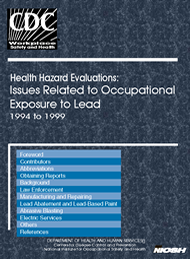Health Hazard Evaluations: Occupational Exposure to Lead
March 2001
DHHS (NIOSH) Publication Number 2001-113

The Health Hazard Evaluations and Technical Assistance (HETA) program responds to requests from employers, employees, employee representatives, other Federal agencies, and State and local agencies. Through a staff of industrial hygienists, engineers, occupational physicians, occupational health nurses, epidemiologists, other health professionals, and support personnel, the HETA Branch collaborates with appropriate personnel in other National Institute for Occupational Safety and Health (NIOSH) Divisions, to respond to approximately 400 requests for assistance each year. The typical HETA response to a request for assistance results in an evaluation of the workplace to determine if chemical, physical, biological, or other agents are hazardous to workers. Control procedures, improved work practices, and medical programs may be recommended to reduce any hazardous exposures found and to prevent adverse health effects. The results of individual evaluations may trigger wider studies of similar exposures in other settings, or may stimulate recommendations for implementation or modification of health standards. More than 10,000 evaluations have been completed since the inception of the HETA program in 1972. Requests received by the HETA program tend to reflect widespread occupational problems, such as lead hazards in the workplace.
This document presents titles and summaries of the 31 HHEs related to lead that were completed between 1995 and 1999. In most cases lead exposure was just one of several exposures that NIOSH researchers investigated at a work site. In many cases, corrective measures were made in response to the evaluation and recommendations made by NIOSH.
Health Hazard Evaluations: Occupational Exposure to Lead [PDF - 857 KB]
- Page last reviewed: June 6, 2014
- Page last updated: June 6, 2014
- Content source:
- National Institute for Occupational Safety and Health Education and Information Division


 ShareCompartir
ShareCompartir